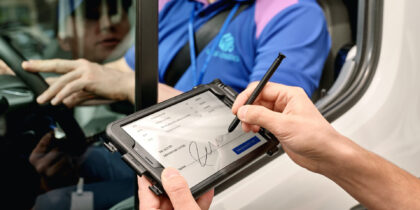Sensor technology is providing new insights for fleet maintenance, giving managers a fresh view into the mechanical health and utilization of expensive assets.
Costs for fleet maintenance and repairs continue to rise, representing a larger slice of the operational expense pie each year. Although we saw truck sales decline during the pandemic, they bounced back towards the end of 2020, and that is still the case as we head into 2022. As a result, R&M costs are most likely going to increase since more miles are being driven per truck, according to the American Transportation Research Institute’s Analysis of the Operational Costs of Trucking: 2020 Update.
That’s where smart truck technology can help. Trucks and trailers equipped with sensors and connected to fleet telematics systems provide insights into the mechanical health of fleets. Sensors measure changes in sound, light, temperature, pressure and motion, and those capabilities can be paired with output devices to communicate that data to other systems.
As a result, sensors provide the ability to get alerts on a variety of mechanical issues, including tire pressure, brakes, electrical systems, lights, engine performance and many other parameters. They can also be used to track events such as temperature changes in refrigerated trailers or doors opening to monitor against possible theft.
Of course, truck fleets have deployed sensors in the past. But that data could only be accessed when vehicles came into a garage for maintenance. Today, onboard mobile devices transmit data in real time or on a regular basis while the truck and trailer are still on the road. Depending on the system, the data is transmitted via telecommunications platforms to the cloud where it can be remotely accessed through dashboards and online management systems.
Here’s a look at three ways sensor technology is influencing fleet maintenance practices now and in the future.
Predictive maintenance
With constant monitoring of vehicle performance, fleet maintenance becomes much more data-driven and predictable. Companies can develop more efficient maintenance plans, cut truck downtime and plan fleet replacements with greater accuracy. Overall, nanotechnology has improved logistics means and procedures such as fleet maintenance by an estimated 57 percent, according to the PwC report, “Transportation & Logistics 2030,” and could prolong overall service life and reduce equipment expenditures.
For example, all the way back in 2010, UPS outfitted many of its delivery trucks with more than 200 sensors that stream data to servers for analysis. The data captured allows the company to service vehicles based on actual use and performance rather than following a one-size-fits-all schedule. That way, UPS can pull trucks out of service at just the right time, reducing downtime and maintenance costs. The telematics also help maintenance techs easily identify specific parts to replace. For example, UPS found that mechanics replaced an entire fuel injector when only an O-ring was faulty, Automotive Fleet reported.
With onboard sensor technology, maintenance systems can send drivers and managers a reminder for preventive maintenance or alert them to looming problems before a standard dashboard warning light would be triggered.
Fleet management
As the cost of sensor technology continues to fall, increased access to vehicle and driver data will allow fleet managers to make better decisions. Fleet management is moving from a collection of independent systems to a holistic view of the enterprise. Managers now have greater visibility into fuel costs, idle time, accidents, compliance violations and other contributors to fleet management costs.
How to modernize fleet management
Get your free guide to improving fleet performance and profitability with in-cab mobile technology. Download Now
Saia LTL Freight Inc. installed sensors and cellular service on its 3,000-truck fleet for real-time data analysis. In the first year, the company increased fuel efficiency by 6 percent, which resulted in $15 million in savings, more than the cost of the initiative, The Wall Street Journal reported. In this way, mobile device purchases can create efficiencies on a far wider scale.
Big data and analytics
IoT-connected trucks can talk back to drivers and managers to deliver more optimized fleet management utilization. Data analytics can help identify trend outliers and inefficient operation that might otherwise go unnoticed. But collecting and analyzing every byte of data can be overwhelming. Instead, enterprises are running analytics at the device and gateway level so that drivers can be alerted of any situation that requires attention, and data can be pushed to headquarters for further analysis.
With these practices, fleet operators can take advantage of the developing technology to optimize maintenance operations, delivering benefits that can transform the bottom line.
If you want to ensure your transportation business is on the cutting edge of technology while being cost-efficient, start by exploring our full line of connected fleet solutions. And get your free guide to improving fleet performance and profitability with in-cab mobile technology.











